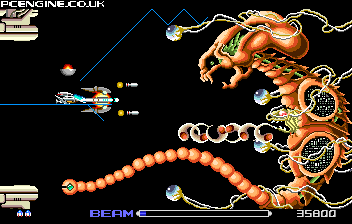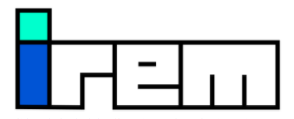1. General Analysis - JosepLleal/PsychoGames GitHub Wiki
| Sections |
|---|
| Design |
| UI |
| Audio |
| Art |
Genre
X-Multiply is a side-scrolling shooter or scrolling shoot'em up, a genre where the player controls a character (usually a spaceship), shooting to enemies and dodging all type of projectiles. The screen normally moves from left to right but there are some side-scrolling shooter games like Air Duel where the screen moves upwards.

R-Type: a left to the right side-scrolling game
In side-scrolling shooter games, it is so typical to have power-ups, which makes the game more entertaining and also easier to complete the challenging levels.
This genre's golden era was between the 80s and 90s with arcade consoles.
Both X-Multiply's gameplay and elements are similar to R-Type and its ships are quite common in the genre. However, X-Multiply differs from the games of its genre because it’s much darker, creating a more horrifying experience.
Similar games
-
R-Type
The player can obtain an drone-looking object called a Force. This feature is highly similar to X-Multiply's tentacles power-up. The Force either be attached to the front or back of the ship or detached to fly freely.
When attached, the Force provides one of three different power-ups. When detached, these weapons cannot be used, but the Force will instead resort to a secondary set of guns
The Force has a secondary use as a shield; it is completely indestructible and can block most things fired at it, as well as damage or destroy enemies on contact, highly similar to X-Multiply's tentacles

-
Darius
Darius is an horizontally scrolling shoot 'em up set in a fictional future. It really differs from other shoot 'em ups because of the fact that it features a screen that is three times wider than usual size
The player controls a spaceship named the Silver Hawk and must navigate through scrolling terrain while facing a variety enemies.
The ship's weapon repository consists of forward-firing missiles, aerial bombs and a protective force field, all of which can be upgraded via power-ups that are dropped by colored enemies throughout the course of the game.
When the player reaches the end of the stage, a boss appears. After you defeat it, the player is given a choice of which zone to play next via a branching path. While there are 28 zones in total, only seven can be played in a single run.

-
Salamander
Salamander is an horizontally scrolling and vertical shoot 'em up.The first player controls Vic Viper and the second player takes the reins of debuting spacecraft Lord British. The two players can play simultaneously, unlike X-Multiply.
Players are allowed to continue from where they leave upon death instead of being returned to a predefined checkpoint just like other Gradius titles. There are no continues in Salamander's single player mode; however, in the two-player mode, players are given two continues.

-
Dragon Breed
The player controls King Kayus, who rides a large dragon named Bahamoot. It is immune to enemy attacks, capable of blocking most projectiles and killing enemies if the enter in contact with it. However, Kayus is not but is armed with a forward-firing crossbow. This game mechanics are really similar to X-Multiply's because of the fact that you have one vulnerable zone and you also have a way to protect yourself via movement and positioning.
The tail of the yellow or blue dragon can be coiled around the player to offer almost complete invulnerability for a limited time.
Bahamoot can also spit fireballs. By holding the fire button down, the dragon will build up fire in its mouth; the longer the button is held down, the more powerful the fireball will be. The game also contains some platforming elements as Kayus is able to dismount on horizontal platforms.

Market positioning
What makes X-Multiply different from the other side-scrolling arcade games is the usage of tentacles as a power-up. The mechanics of the tentacles are also pretty interesting, apart from also shooting, if the spaceship moves forward the tentacles move back and vice versa. This power-up can be used for melee attacking and to block enemy projectiles.

Part of the X-Multiply's flyer
Technical Profile Irem M-72
| Image | Component | Features |
|---|---|---|
| NEC V30 | The NEC V30 was a version of the NEC V20 that was pin compatible with the 16-bit data bus Intel 8086 processor. It ran at 8MHz. It was used in many fields but to us, the most important is that it was implemented in various arcade machines (especially ones made by Irem) in the late 1980s. | |
| Zilog Z80 | The Z80 CPU is an 8-bit based microprocessor. The CPU had a base frequency of 2.5 MHz but it could be clocked up to 8 MHz with CMOS variant up to 20 MHz. In this particular build, it ran at 3.579545 MHz | |
| Yamaha YM2151 | The Yamaha YM2151, is an eight-channel, four-operator sound chip. It ran at 3.579545 MHz. It was Yamaha's first single-chip FM synthesis implementation, being created originally for some of the Yamaha DX series of keyboards |

- Note: The IREM M-81 build was highly similar compared to the IREM M-72. It featured the exact same components. We found out the it was more integrated than the previous version.
History of the Game

X-Multiply, developed and published by Irem, was released in 1989, the same year as R-Type II. While this was essentially just a less inspired sequel, X-Multiply brings more interesting and refined elements to the table. It's an excellent shooter that remained tragically obscure, mostly due to it not being ported to any home platforms at that time. It remained arcade exclusive until 1998 when it was bundled along with Irem's Image Fight as part of the Arcade Gears series, a series of arcade ports for the PlayStation and Saturn released by Xing.

X-Multiply & Image Fight flyer for Sega Saturn and PlayStation
Return Home